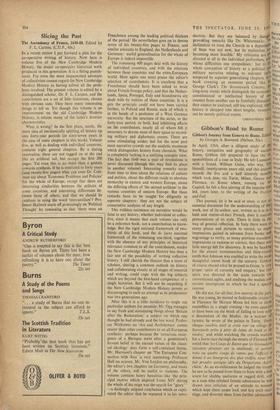history is chopped into short lengths, measu ll 4 de‘w
Gibbon's Road to Rome
Gibbon's Journey from Geneva to Rome. Edited by Georges A. Bonnard. (Nelson, 50s.) IN April, 1764, after a diligent study of the history, antiquities and geography of ancient Rome, Gibbon felt prepared to face the nr with a friend, William Guise, who was. II° himself, twenty-seven years old, and this journal records the five and a half leisurely months which took him, via Turin, Milan, Genoa and Florence, to Rome where, musing on the Capitol, he felt a first stirring of the impulse that
sponsibilities of a tour in Italy. He left Lausanne
led, years later, to the writing of the t")?,-lies and Fall.
This journal, let it be said at once, is not all essential document for the understanding of that work, nor of its author, nor, written as it is in a bald and matter-of-fact French, does it contain premonitions of its style. There is little in the way of general reflection. In Italy there were so many places and pictures to record, so many impressions gained in advance from books and engravings to verify, so many previous travellers' impressions to endorse or correct, that there was little energy left for discovery. It was by head;n8 for the almost monumentless and little-visited north that Johnson was enabled to write the most thoughtful travel book of the century. Gibbon of course shared what he praised in Guise, 'a /ell proper spirit of curiosity and enquiry,' but this spirit was directed in the main towards the conventional sights, and studying the medals and ancient inscriptions in which he had a special interest.
He did not, for all that, live entirely in the past. He was young, he moved in fashionable circles-- in Florence Sir Horace Mann led him to three assemblies in a single evening—he even appears to have been on the brink of falling in love with a descendant of the Medici. As a scorner of tyrants, he wrote of the palace in Turin, 'Darts chaque lambris (lore je crois voir un village de Savoyards prigs d perir de faim, de froid et de misere,' and while watching the crowds waiting for a horse race through the streets of Florence ho noted that 'les Coups de Baton que les Grenadiers faisoient pleuvoir sur la multitude. et surtout trois ou quatre coups de canne que l'officier a donne a un bourgeois des plus etoffes, nous on/ fait prendre quelque idie du Despotisme Autri- chien.' As an ex-militiaman he judged the troops he saw as he passed from State to State with a fine scorn for shabby uniforms or ragged drill, and irl as a man who relished female admiration he was s11 drawn into criticism of an attitude to women to which kept them under lock and key until mar- rine, and diverted them from further adventures ti'
thereafter by means of that licensed half-lover. the cicisbeo.
He and Guise were industrious gallery-goers. After each visit—they made fourteen to the Uffizi—Gibbon listed the objects that had attracted him most, and these entries give a Clear picture of his taste. Apart from a disl'ke for Veronese, it was conventional. Of qua:ft-o- ccur° art there is scarcely a mention. At San Marco there is no word of Fra Angelico. in Milan none of Leonardo's Last Supper. In com- mon with his age he admired the marble walls of the Medici chapel in San Lorenzo more than Michelangelo's tombs in the adjacent sacristy The artists he valued most were Rubens. Guido Rent, Domenichino, Correggio, Annibale Caracci and Titian, and the qualities he most admired were grace. narrative decorum and illusionism. The age of reason speaks almost in caricature when he scolds the builders of Milan Cathedral for sticking statues on pinnacles where no one can see them properly, or breaks out. When looking at Correggio's dome in Parma With the indignant query. 'Pourquoi representer deS fiettres humaines sur un fond qui est au deAsus de ma tote, sans aucun appui qui empeche Ir.ur pro pre poids de les precipiter en bas? Ce .est (pie des ,catches que ie voudrois peindre outsi.' In the Uffizi he became impatient with drawings and sketches as being formless antic'- nations of the finished work, and his fullest ad- miration was reserved for an art which could be finished in its entirety, sculpture; faced by the Medici Venus he broke for the first time into Capital letters. Here and elsewhere his liking for voluptuous verisimilitude, for breasts and bot- toms, for athletes' stomachs, his rather unusually close scrutiny of the Florentine Hermaphrodite. represent the nostalgia of a classically educated and corseted century for nakedness. M. Bonnard leaves us to draw such conclusions for ourselves. He has put the text before us with love, learning and modesty. It is not a discovery. Parts of it were quoted in the Miscellaneous Works, and many of the best passages were translated in D. M. Low's biography. But here We have it entire, •happily illustrated with con- temporary prints and paintings. and, with this book to supplement the editor previous Publications, the whole of Gibbon's journal is now meticulously in print.
J. R. HALE



































 Previous page
Previous page